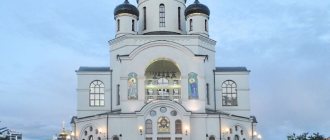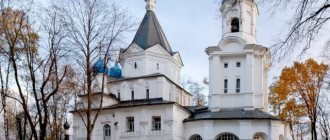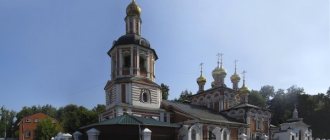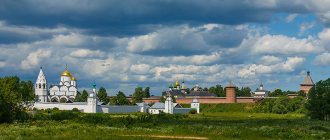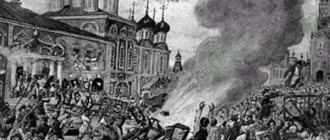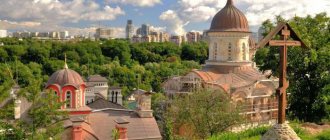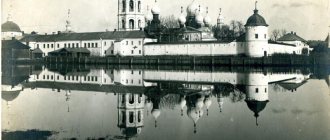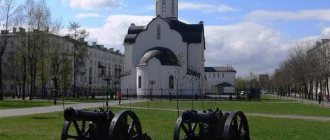It’s not for nothing that the Inkerman St. Clement Monastery is called a cave monastery; it is carved right into a steep rock, in which the monks live. This is the oldest temple of the Simferopol diocese, dating back to the 1st century AD. His life path cannot be called easy. The temple was a fortress, a refuge for exiles, a home for hermits.
The owners of the picturesque place changed, and religion changed along with them. During the period of Soviet power, the temple was completely closed. Most of the monastery was destroyed. But more than half a century later, life was breathed into the monastery again. Nowadays, divine services are continuously held in the monastery, the temple actively receives tourists and pilgrims coming here from different countries.
How to get there by car
The car route to the cave monastery runs along the Simferopol highway in the direction Simferopol-Sevastopol. Leaving Mr. Inkerman behind, we need to move forward. Before reaching the bridge over the Chernaya River, turn left near the gas station. The temple cannot be seen from the road; it is hidden by a railway embankment and lush vegetation.
The only landmark is the ruins of Kalamita. It is prohibited to enter the territory of the monastery, so there is free parking for cars near the road. Then you need to walk to the tunnel built to the monastery under the railway tracks.
Legends about the temple on Fiolent
One of the old legends tells about an event in 890 -
when Chersonesus was part of Byzantium. On Fiolent, local fishermen became victims of a shipwreck in bad weather. Then the cape was called Parthenium (“place of the Virgin”). Having lost all hope, the fishermen appealed to the Great Martyr St. George the Victorious. He heard them and saved them, giving them a gift in memory of what happened. The next day, the townspeople carved a small temple into the rock and placed the icon given to them there.
Some of the rescued began to live in a cave - people became ascetics. The myth says - thus, the forerunner of the current men's monastery was born. By the way, the celestial being appeared on the reef - the place was called the Rock of the Apparition of the Saint. It is still visible both from water and from land. Many centuries later, Russian ascetics settled in the rock church. In an incomprehensible way, the Victorious filled not only them, but also the Russian sailors with courage and determination. After visiting the monastery, people heard the voice of the saint.
How to get there by public transport
There are several ways to get to the monastery by public transport:
You can get to the Inkerman Cave Monastery by regular bus.
| By bus | By train | On the boat |
| Take the Sevastopol-Inkerman intercity bus to the Vtormet stop, then walk about 500 m. If you ask the driver, he will stop right next to the monastery. The route from the “North Side” area runs by regular bus No. 106, departing from Zakharov Square. From Sevastopol, take a trolleybus to the “5th km” stop, then change to minibus No. 103 or No. 117, get off at the “Inkerman” stop, and walk to the monastery. The bus ride to the temple will take 30-45 minutes, depending on the route chosen. | Take the Sevastopol-Simferopol train, running from the railway station at intervals of 30 minutes, to get to the station. "Inkerman". The train will deliver you to the place in about 45 minutes. Due to the very close location of the temple to the tracks, from the windows of the train the monastery is as if in the palm of your hand. It feels like you can touch it with your hands. After getting off at the station, cross the bridge and walk a little more. | A boat runs from the Count's pier to the monastery twice a day. The journey there will take about 50 minutes. |
The monastery domes will help you get your bearings; they are visible from afar. You can only get inside the temple through a tunnel in the railway tracks. If you book an excursion to the monastery, then the route to it will be the task of the guide, which will greatly alleviate the problem.
Question answer
How to dress to enter the territory of the St. George Monastery?
No special requirements other than standard ones. Shoulders and knees must be covered, and for women, their heads must be covered. Unpleasant moments arise when vacationers try to enter the territory in beachwear. As for the trip to Fiolent in general, keep in mind that it is always windy there. And, as a result, in cold times the temperature is 2-3 degrees lower than in the center. Well, in the summer you can quickly and unnoticeably burn out.
Where to eat after the excursion?
In the center of the park there is the “Monastery Tea House”. A round glass building where you can drink coffee or herbal tea with fresh pastries. They also sell souvenir jars of honey and jam. And “Sevastopol gingerbreads”, reminiscent of Christmas ones.
Does the boat go from St. George's Monastery to Balaklava?
Yes, although this is not a boat, but boats carrying tourists from Jasper Beach to the Balaklava embankment. They go in the summer. You can plan it like this: take a walk in the park, enter the monastery territory, go down to the beach and board a yacht to Balaklava. The only point: there is no pier on Jasper Beach. And when climbing onto a yacht, you can wet not only long clothes, but also shoes. “Fiolent and Balaklava” - excursion by car. If you are short on time, this is the best way to see two picturesque places in Sevastopol in 5 hours. “Fiolent and the cave monastery of Kachi-Kalyon” is another “two in one” excursion. Duration about 6 hours, carried out in a guide's car.
Is it true that the descent from the monastery to the beach is very steep?
Not that word! But the stairs have been restored and are safe. So the descent is no longer as difficult as before. The climb is more difficult: 600 steps is still a lot (no matter how good the stainless steel railings look).
History of the monastery
The Inkerman Cave Monastery was founded in quarries where white building stone was mined. This is the oldest temple in Crimea, created in the 1st century AD. 4th Pope – Clement. He held his first services here back in 1992. Exiled to the Inkerman quarries for preaching the Christian religion, he organized a flock of convicts like him and continued his good work.
About 2,000 exiles from Rome and Greece gathered for prayers in a gloomy room carved into the rock.
Clement, who had previously been a student of the Apostle Peter, was actively followed and information was passed on to Emperor Trojan. The emperor, who hated Christianity, ordered the death of him and several other parishioners in order to clearly demonstrate the fate awaiting the rest of the followers. Clement was drowned on a dark night in 101 AD. The "temple" ceased to exist.
Around the 8th century AD, monastic cells appeared next to the cave where Clement preached. The passages from one to the other looked like an ornate tunnel. With their appearance, a monastery was created, most of which was carved inside the rock. It was named after Saint Clement, who died for his desire to preserve Christianity.
The monastery led a quiet, humble life until the third quarter of the 15th century. When the Turks attacked Crimea in 1475, the wave of persecution of Christians resumed. Under their yoke, the monastery fell into decay, most of it was destroyed, the property was plundered by the British and Turks. Having failed to recover, by 1778 the temple was completely deserted. Only majestic rocks rose above the ground.
A new stage in the revival of the Inkerman Monastery began in 1850. Having restored the desolate monastery, they cut out 3 more temples in the rock, equipped the courtyard and cells. Since then, he confidently carried out his mission until the 30s. XX century, until it was closed with the advent of Soviet power.
In 1910, the monastery was slightly expanded, due to the increase in the number of brethren - they created a house church, a parochial school and 2 above-ground buildings for the brethren. After another 7 years, 25 monks and more than 100 novices already lived there. And in 1920, the monastery provided support to the troops of Major General P. N. Wrangel, in the withdrawal of the army from the Crimean ports.
With the communists coming to power, the activities of the monastery were suppressed, the chapel erected on the grave of soldiers who died in the Battle of Inkerman was destroyed, and the temple was closed. His property was transferred to the Simferopol Museum. But after the closure, despite the fact that the temple no longer officially existed, Abbot Benedict lived in it for some time with 2 elderly elders. No services were held.
During World War II, the caves of the former Inkerman Monastery sheltered the headquarters of the Chapaev Division. In 1942, its fighters held back the Germans rushing to Sevastopol.
The dawn for the monastery came with the arrival of Archimandrite Augustine of Polovetsky as rector in the 90s. XX century. Thanks to his efforts, the monastery began to be rebuilt again. In 20 years it has been restored almost completely and has 5 functioning churches.
Don’t miss the most popular article in the section: Map of the Black Sea coast of Russia with resorts: cities and towns.
History before the founding of the monastery
The first signs of human habitation appeared here in the 6th century BC - it was a settlement of slaves who mined stone in local quarries, which was used in the construction of Chersonesos
Tauride. When Southern Crimea became part of the Roman Republic in 63 BC, the Romans built the Kalamita fortress on the plateau of Monastyrskaya Mountain.
When these lands went to the Byzantines in the 5th century, they significantly increased both the fortress itself and the perimeter around it, surrounding everything with a fortress wall stretching for 11 km, and dug a ditch. Over time, a small city with numerous buildings grew around it - both on the mountain itself and in its thickness, where cave temples and monastic cells arose.
With the decline of the Byzantine Empire, Kalamita itself found itself in significant desolation in the 12th century. With the rise of the Principality of Theodoro in the 14th century, the fortress structure was rebuilt, and after the conquest by the Turks in 1475 it became known as Inkerman, which is the name of the modern Sevastopol suburb.
Architectural ensemble of the monastery
The Inkerman monastery is now a complex of 3 cave and 2 ground churches, a utility block, as well as living quarters for the monastic brethren. Ground temples - the Church of the Holy Trinity and the Temple of Panteleimon the Healer - are located at the foot of the cliff. An underground tunnel leads to them from the road.
After passing through the small monastery courtyard, decorated with a dome at the entrance, you will find yourself in front of a narrow door in the rock, opening a staircase that leads to the cave temples.
For example:
- St. Clement - consecrated in 1852, 2 years after its creation;
- St. Martin the Confessor - consecrated after minor redevelopment in 1867;
- Andrew the First-Called , consecrated in 1900, although this is the most ancient temple of the 3, it was cut down by Clement himself.
All of them are united by a common corridor. Studies of the rocky terrain revealed traces of the existence of 9 cave monasteries connected by a complex tunnel system and about 30 temples. All but 5 operating ones are in disrepair. They were severely damaged by the earthquake that occurred in 1927, some were damaged during the fighting.
In 1932 they decided to dismantle them.
200 artificial caves carved out at different times were discovered on the rocky slopes. These caves are the largest component of the monastery complex. Of particular interest is the new fraternal building located on the ground. Bullet marks were preserved on the façade of the restored building in memory of the Crimean War.
Other cave monasteries in Inkerman
Moving along the railway embankment to the Black River valley, an inquisitive traveler will discover the Zagaitan rock, rarely visited by tourists. There are about 120 cave hermitages and churches in the rock, arranged in distinct tiers. Previously, according to historians, this complex was subordinate to the Inkerman Monastery. Today, most of the objects have been destroyed by scree and vandals. When exploring abandoned caves, be careful and evaluate your strength!
Another interesting monument is the monastery of St. Sophia, located on the left bank of the Chernaya River. During the time of the Principality of Theodoro, the monastery was founded on the western part of the Stone Ravine and became the largest of such complexes. The monastery has 22 rooms and 4 cave churches. The main St. Sophia Church is located in the second tier. Some of the premises are filled up.
Architect and exterior decoration of the cathedral
The monastery, hidden in the ruins of a fortress, impresses with its unusual whiteness among the gray rocks. Its snow-white above-ground buildings are perfectly visible from the windows of the train rushing to Sevastopol, since the fence of the monastery is located right next to the railway track.
Responsible for the architecture of the temple, which was restored at the end of the 18th century, is the architect and artist D.M. Strukov. The external and internal simplicity of the buildings emphasizes the severity of these places and the strength of faith of the servants of God living in the rock caves. The names of those who were involved in its arrangement in the future, unfortunately, are not known.
The monastery gate is located under a 40 m rock. Behind them is a panel depicting the temple saints. Next is the cemetery, from which the staircase into the rocks begins. In the middle of the courtyard there is a monument to fallen soldiers. The doors to the cave temples are guarded by images of the archangels Michael and Gabriel.
The main temple is the Church of St. Clement. The ark with his relics is kept in it. The rectangular structure unites 3 naves of different heights, is divided by 2 rows of columns and is shaped like a basilica. The exterior of the building, covered in white plaster, is quite simple and has little or no decoration.
Only the upper part of the apse is decorated with a large cross carved into stone in the Byzantine style, from which simple plant shoots spread out in a semicircle. It is the largest in size. The rest of the cave temples are gloomy and low.
The rectangular Church of St. Martin the Confessor, covered with a semicircular dome, has no external decor, like the Church of St. Andrew the First-Called, the low ceilings of which perfectly emphasize its cave origins. Historians believe that this particular room was cut down by Saint Clement. Preserving the memory of the creator, its dimensions have not changed to this day.
Due to the limited space of cave churches, festive services, which attract many parishioners, are held in the above-ground Church of the Holy Trinity, located behind the fraternal building. Its snow-white building is irregular in shape, dotted with many windows without frames, opening onto small chapels. Thanks to the large number of windows, the room is well lit.
Partially above ground, the Temple of Panteleimon the Healer was built in the Byzantine style. A rectangular building with rectangular windows and a door, undecorated. There are belfries located in the rock above the temple. It was erected in 1895, in memory of the family of Alexander III, rescued near the railway station.
Of particular interest are the balconies scattered along the slopes of the rock, built in numerous caves. From a distance they resemble intricate bird's nests. The paths are paved with paving stones, the courtyard is neat and clean. A pond and flower beds complete the landscape. The temple is separated from the railway tracks by a high metal fence.
Restoration in the 19th–20th centuries
After the annexation of Crimea to the Russian Empire, the restoration of the monastery began, but without any special financial investments.
In 1852, the Church of St. Clement, followed in 1867 by the Church of St. Martinian, who suffered greatly during the Crimean War. Like a phoenix, the Clement Monastery was reborn every time, attracting more and more pilgrims.
New churches are opened, the monastery is visited by great princes, among whom was Alexei Mikhailovich. In 1910, the monastery consisted of two buildings for the monks to live in, in one of them a house church was equipped, and a parochial school was opened.
Inkerman Clement Monastery, early 20th century
The civil war and revolution led to the monastery being closed in 1929, but four faithful monks remained in the caves near it.
In memory of the battles around Inkerman during the Great Patriotic War, there is a monument to the soldiers of the 25th Chapaev Division, located in the monastery courtyard.
Interior decoration
The inside of the monastery looks as simple as the outside. But this roughness and gloominess of the caves does not in the least affect devotion to God. It only shows the power of true faith. D.N. was also involved in the arrangement of the interior of the monastery. Strukov. He painted it himself with icons. According to his decision, the ceiling, right on top of the rough cutting, was covered with silver paint, and the floor was laid out with boards.
There are icons hanging in the passages between temples, but they look rather gloomy. The long corridor leading to the main temple has several benches carved into the stone. A niche was cut into the wall of the temple for the altar image, a two-stage arched bench for the spiritual father was carved under it, and a high place was located in the center.
The frescoes have not survived to this day, except for the one that depicts the Savior on the throne. It was decided to move the linen iconostasis from St. Clement’s Church to the Church of St. Martin. Instead, they installed a galvanized, gilded iconostasis on a stone throne.
During the restoration of the Church of St. Martin, its original appearance was disrupted by a slightly expanded apse, which gave it some unevenness. The throne in it fits tightly to the wall. In a rocky niche, under glass, there is an ossuary with the skulls of buried people. The inscription on it - “We were just like you” - makes you think seriously about life.
The Church of St. Andrew the First-Called is located in a small cave. The ceiling hangs directly above your head. There are only 2 windows inside. The one on the right has a seat carved into the stone; here the Holy Father confesses to the parishioners. At the left window there is an altar separated by a partition. An altar was built under the window; wine and bread were served through it during the service.
A small niche is carved at the top for storing vessels. The throne is also adjacent to the wall.
The peculiarity of the Temple of Panteleimon the Healer is that its altar is carved directly into the wall, and the iconostasis is lined with glass mosaics. The ceiling of the temple is decorated with a large forged chandelier. The Church of the Holy Trinity is a little more spacious, but the interior decoration is as modest as in the other churches: a stone altar, an altar, icons and gloomy gray walls dotted with many windows.
The emergence of the monastery
Interfeudal wars were fought in Crimea, fortifications and fortresses were built, one of which, Kalamita, protects the Inkerman St. Clement Monastery with its ruins to this day.
Under the protection of Orthodox Byzantium, under whose protection Crimea passed after the collapse of the Roman Empire, the monastery began to be built. Utility rooms and caves were carved into the rocks for the monks to live. In one of the caves there was a stone throne, an altar and even benches. Steep staircases with steps carved into the rocks connected the temple premises.
Since 1475, after the capture of the peninsula by the Turks, the Christian monastery was abandoned until the seventeenth century.
In the middle of the 17th century, a certain Father Jacob, while visiting an abandoned temple, discovered holy relics. However, none of the local residents could remember who they belonged to.
The Turks tried several times to bury the remains, but they miraculously returned to the temple.
Wanting to take the holy, incorruptible remains away from desecration, Father Jacob was stopped in a dream by Saint George the Victorious, who revealed to the priest the name of the owner of the relics.
Shrines and relics of the cathedral
The Inkerman Cave Monastery considers a particle from the head of St. Clement to be its main shrine. The ark with it is kept in the nave of the St. Clement Church. In addition to her, the relics of Panteleimon the Healer and St. George the Victorious are revered.
In the ossuary of the Church of St. Martin there are 12 heads of people exiled to the Inkerman quarries. The monks pray here and believe that the dead not only hear, but also pray for the living.
The small ark contains the relics of the Kiev-Pechersk saints:
- the wonderworker Agathon of Pechersk;
- Bishop Nifont of Novgorod;
- Equal to the Apostles Mary Magdalene;
- The much-sick Pimen;
- Andrew the First-Called;
- Bethlehem babies.
Composition of the complex and location
The St. George's Monastery was visited at various times by Russian tsars, artists and cultural figures. The monastery impressed Pushkin and Chekhov, Bunin and Ostrovsky. During a short visit, Aivazovsky managed to capture the image of the monastery in a black and white sketch, where the artist managed to capture a piece of his beloved sea. Balaklava St. George Monastery is located between Sevastopol and Balaklava on Cape Fiolent. The monastery consists of several areas that form a single composition:
- West Side. Here are the monastery refectory, chapel, holy spring, Church of the Nativity and Church of St. George. The same one that was destroyed during the 1927 earthquake, but later reconstructed.
- Plateau . From here you have a beautiful view of the sea and the coastal strip. There is a chapel, a bell tower, and a military library in the building of which there used to be a temple. Two monuments were erected nearby (to St. Andrew the First-Called and A.S. Pushkin).
- Surroundings of the monastery. Not only the monastery itself, but also the picturesque beauty around it deserves the traveler’s attention. Here you can find the very gazebo in which Pushkin once rested, St. George's Rock with a memorial cross, a necropolis and Jasper Beach, rightfully considered the best in Crimea. By the way, the same staircase, erected in honor of the millennium since the founding of the monastery, leads to it.
Finding the monastery is not that difficult. For those who are going to travel from Simferopol, they will have to plan a route through Sevastopol. From the city you need to go towards Yalta along Kamyshovaya Highway. Near the bus station you need to exit onto Khrustaleva Street and turn onto Monastyrskoe Highway, which leads to the coast. In total, the journey will take approximately one and a half hours.
Mentors
The very first abbot of the monastery was its creator, Clement. For the most part, information about the mentors of the revived monastery has not been preserved. Among the modern clergy, the most famous are Father Tikhon - kind, bright and humorous, who entered the monastery after serving in the navy, and Archbishop Luke, who replaced Father. Tikhon after his death.
Luka, who was already in old age, zealously began to restore order, sparing no effort, and not letting anyone down. Many considered him an arrogant and ambitious minister. A former surgeon, he continued his medical practice, accepting patients at home for free.
In the early 90s. In the 20th century, Archimandrite Augustine was elevated to the post of rector; in the world - Alexander Polovetsky. It is to him that the monastery owes its revival after its closure under Soviet rule. In addition, he painted the iconostasis with his own hands. In August 2015, Archimandrite Kallinik (Chernyshev) was appointed to the position and he still holds it.
Inkerman Fortress
Also on the territory of the Inkerman Monastery are the ruins of the ancient medieval Byzantine fortress of Kalamita. Only the remains of some watchtowers and a few other fortifications have survived to this day.
The name of the fortress Kalamita translated from modern Greek means “beautiful cape”, and from ancient Greek it means “reed”. Today, the fortress is included in the list of objects of the Tauride Chersonese National Nature Reserve.
© Margarita Kushnirenko
Patronal holidays
The monastery annually celebrates 6 temple holidays:
- December 8th is St. Clement's Memorial Day.
- December 13 is the day of memory of St. Andrew the First-Called.
- April 27 is the day of remembrance of Martin the Confessor.
- August 9 is the day of memory of Panteleimon the Healer.
- August 19 – Transfiguration of Christ.
- Day of the Holy Trinity.
The festive service is conducted by the current rector, Archimandrite Kallinik. The celebrations invariably acquire a wide scope, since a huge number of pilgrims and parishioners of the temple gather for the service. They are often attended by tourists.
Interesting facts about the monastery
The Inkerman cave monastery was unusually favored by crowned persons. Their donations were more than generous. Emperor Alexander II, for example, donated 1000 rubles to the monastery. to commemorate those who fell in the battle of Sevastopol, and also donated 3 shares, the value of which was 375 rubles.
The sudden appearance of water in the dry Holy Spring due to construction in the quarries is considered a real miracle. Fresh water gushed out of the rock when, during a period of sweltering heat, Pope Clement selflessly prayed over it. People believe in the healing power of the spring and strive to bathe in it.
Church property, which was transferred to the Simferopol Museum during the closure of the monastery and became exhibits of its exhibitions, unexpectedly quickly became damp. After which everything had to be removed.
Hieromonk Agapit and Archimandrite Augustine, who died in a car accident in 1996, are buried at the foot of the Monastyrskaya rock. The monastery servant who arrived to collect the bodies saw the pathologist remove bullets from the archimandrite’s body. It was not possible to prove the version of a contract killing, but their grave in the church cemetery is especially revered.
Monastery of St. George the Victorious today
St. George Monastery in Sevastopol, Cape Fiolent, received its name in honor of St. George the Victorious, revered by the Greeks. His life is full of various interpretations and later additions to the main story. According to the generally accepted version, George was one of the favorite warriors of the Roman emperor Diocletian and a secret Christian.
During the persecution of the emperor, he himself declared himself a Christian and suffered the greatest tortures, at the end of which he was killed by beheading. One of the saint's most famous miracles is his victory over a dragon or serpent, which he defeated by piercing him with a spear. This story is the posthumous miracle of the saint.
Saint George is revered as the patron saint of warriors, hunters and farmers; people turn to him in prayers for the harvest and healing from various diseases.
Today, the St. George Monastery is one of the architectural monuments, and also has important spiritual and secular significance. It is a symbolic place for the Black Sea Fleet; the most important ceremonies take place on the territory of the monastery.
Information for visitors
Entrance to the monastery is free, but you can make any donation amount to the cash desk located at the gate. The recommended amount is at least 150 rubles. Also at the entrance to the monastery you can hire a guide (from among the clergy of the monastery). Excursions are held daily, in groups of up to 5 people, from 8.00 to 18.00, they last 20-30 minutes. The cost for everyone will be 500 rubles.
Before taking a tour of the monastery, you need to check whether there is a service going on at this time. Because you cannot enter churches during services, and they take place on the street.
If the excursion was pre-booked by telephone, then the pilgrims who ordered it are given a discount.
Photography and video shooting inside is prohibited. For people dressed inappropriately, aprons (instead of skirts) and head scarves are available. On the territory there are church shops where you can order a simple lunch and buy candles. In one of them you can buy monastic herbal tea and religious literature.
The monastery will accept the following as donations:
- warm shoes and clothes for men;
- flower vases, carpets or carpets for the improvement of the monastery;
- "Cahors";
- black material for making vestments.
When is the best time to visit the attraction?
If you want to listen to the guide, then arrive before 17:00. The ticket is sold at the box office and costs 100 rubles. The ticket office is closed from 17:00. You have the opportunity to wander around the territory alone and calmly, without rushing, examine the amazingly beautiful icons inside and the cozy courtyard outside. After 18:00, the doors of the premises, church shops and the ticket office are closed and you will no longer be able to get inside.
One last piece of advice. Take your time to run inside the stone rooms. Stand a little in front of the entrance, listen to yourself and feel the atmosphere of this ancient place. If you decide to make a wish, then remember: only a good dream comes true here!

